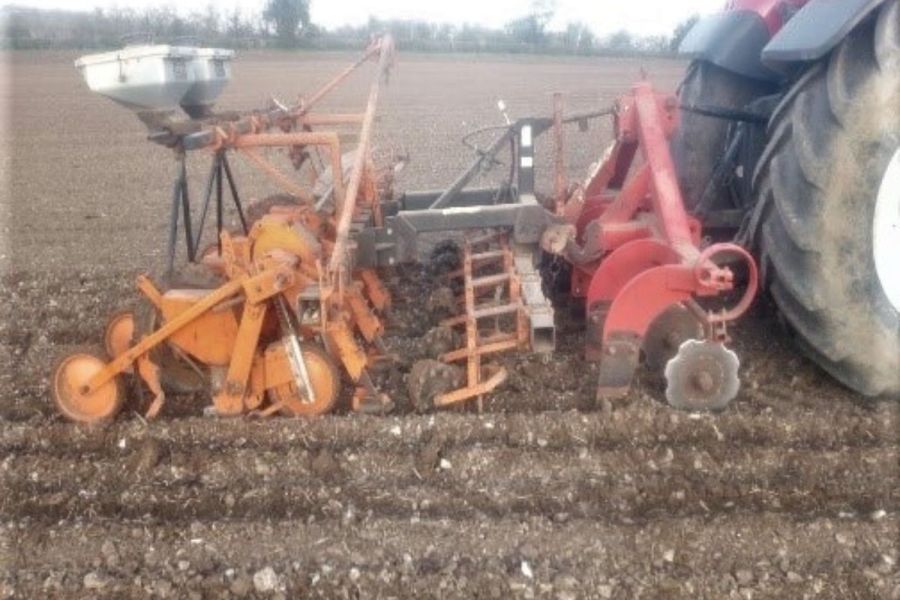By Andrew Wilson
Back in February, when it was dry, we were about a fortnight ahead of ‘normal’ with our workload. Now, it’s fair to say we’re a fortnight behind, like most of the country. It’s wetter now than at the turn of the year.
Having sown our spring beans back in February (thankfully), as I write this on 23 April, we’ve just this week strip tilled our spring barley (after wheat) and direct drilled spring oats on heavy land where oilseed rape has failed. A combination of a dry start, slugs, pigeons and flea beetle have taken their toll, so having not applied any restricting herbicides, and barely 10% of the crop being worth keeping, the OSR had its final input – glyphosate. I now remember why I stopped growing the stuff back in 2010!
The oats are mostly farm-saved Canyon for milling, with a trial of Isabel. The spring barley sees us return to malting after a few years of lacklustre premiums, with Laureate the variety of choice taking over from long-serving Propino
Winter barley looks superb currently, having had nearly all of its inputs now. Wheats are a bit more variable in disease susceptibility and growth stage but have had 75% of their nitrogen, potash, sulphur and their first fungicide, with T1 looking like being a week away. Winter beans look as good as I’ve seen them for many years. Cereals ‘23 look promising, we could just do with prices to recover a bit over the next few months.
Sugar beet drilling has started, with about a quarter of the crop currently sown. The beet is nearly all Conviso variety, Smart Rixta KWS, and I’ve drilled the Cruiser-treated seed first, thinking it will be slower growing and more vulnerable to aphid damage than the last sown crops. Those crops without Cruiser will see a few experiments this time – garlic extract in furrow on some, and a couple of (unsprayed) strategically placed flower strips to encourage beneficial insects. We also plant a nurse crop of spring barley while we’re fettling the beet seedbed, which gets growing quick enough to protect the beet from wind and hopefully discourages aphids from landing and infecting the beet with virus yellows.
Time will tell whether or not we’re wasting our time, but we must keep trying new things to retain our crop’s sustainability. Most of the beet will have Consortium Plus and a little nutrition placed just under the seed to get it growing out of the blocks quickly.
We’re yet to start potato planting here, but I envisage (hope) the wheels will be turning by the time you read this. We have nearly 40% less acres to plant this season, which has eased the urgency a little. Royal seed is chitting nicely in Blackburn crates and has currently amassed 174 day-degrees since it arrived in the second week of March. Innovator and some trial varieties are boxed up, waiting for action in a store with a fridge managing to hold it at 6⁰C, at a not inconsiderable expense.
Soil temperatures are stubbornly refusing to hit double figures here at the moment, mostly I think due to incessant rainfall. It remains to be seen whether 2023 will be another drought season, or a repeat of the monsoon that was 2012. If I was a gambler, I’d be erring towards the wet side of average here, given that a wet season usually follows a dry one in these parts historically – but that maybe me just trying to avoid the headaches of irrigation!
Last year’s potato crops are now all delivered, with results about what we expected at 78% of contract as an average across all varieties. Irrigation was worthwhile, but our analysis and observations show that it was the very high temperatures, rather than necessarily a lack of water, that held yields back. It was noticeable that heavier land, and particularly limestone, kept cooler and performed better than those on sandier soil types that naturally get much hotter. Organic matter also had an influence on crop resilience (be it naturally, or from additions like FYM or big cover crops) and bigger canopies generally fared better in the challenge that was 2022.
One surprise was that sprouting in store was much less than anticipated. In a hot season, where the physiological age of the daughter crop is higher, we generally see dormancy break early, with more vigour than in a cold season. We did manage to find a window to apply maleic hydrazide onto most of our crops. It’s my view that the lower yielding crops absorbed more active ingredient per tuber than was the case in higher yielding fields and this translated into less sprout and weight loss in store. The two untreated fields certainly showed how vital this product is to the processing industry.
It’s fair to say that I’m a bit of a tech cynic – at 46, I’m one of the last to school using paper rather than a screen – but that doesn’t mean my curiosity isn’t activated occasionally. We’ve had RTK steering for 14 years now, and auto-section on the sprayer for 10, but have thus far not been convinced by irrigation probes or that variable rate anything is worthwhile on our ground. That all said, 2023 will see me dip my toe in the waters of yield modelling. Interesting it may be, but it will need to deliver a value greater than its cost to stay around, much like the other myriad of inputs for our crops. Watch this space…
This article was taken from the latest issue of CPM. For more articles like this, subscribe here.
Sign up for Crop Production Magazine’s FREE e-newsletter here.




